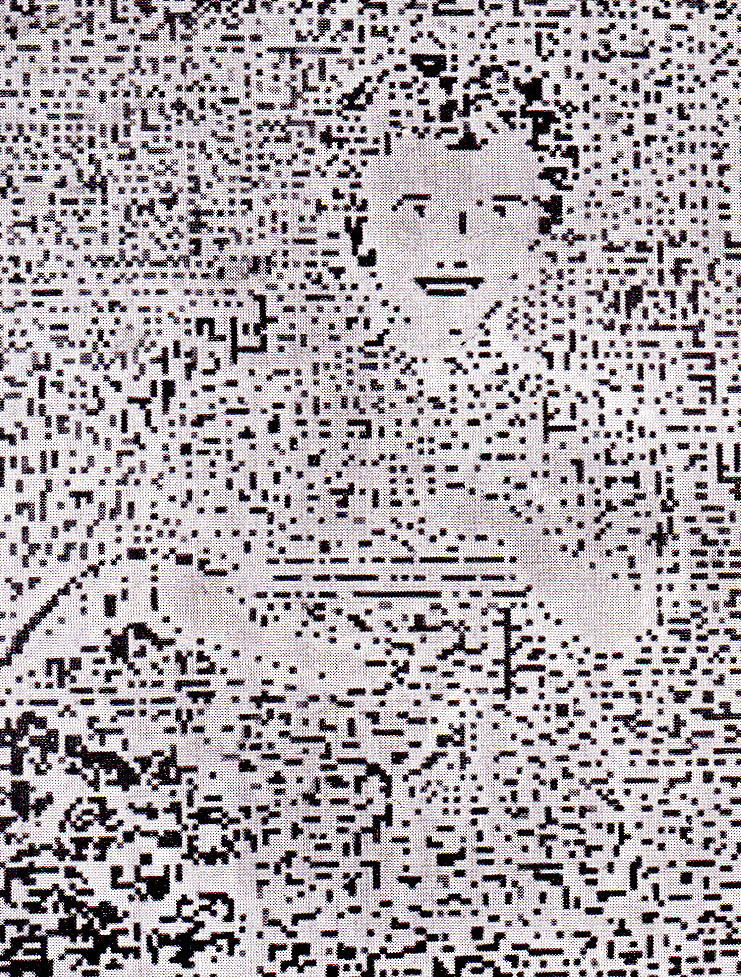
During the 1960's Alberg Ducrocq shows first pixelated images as well as a stochastic poem generator, Calliope
The 1940-1950's.
Emergence of the true digital.
The digital context.
Index of the "digital" artists of this period.
Index digital artists of the 1940's, of the 1950's.
During the 1940's, digital devices are busy with war, and digital arts do not show meaningful advances.
After the war, support to artistic applications comes from several computer manufacturers, such as IBM, Bull or Olivetti and large companies as Bell Labs and Boeing. The artistic applications are seen from start. But with limited applications due to the cost of the machines. It will take half a century to have computers on every pocket with smartphones. In the 1950's, some art works are still pre-digital, other are already using computers.
The terminologic issue created with the central role of binary, or digital systems, will diffuse in arts with different solutions. (We anticipate here on the future decade).
- Computer is the main term used: computer graphics, computer music
- Electronics (or Electro) will appear in music much later, and down to 1999 in literature (creation of the ELO).
-
Note the creation of digitally oriented artists groups: Gruppo N and Gruppo T in Italy. They will be followed in the next decade by Nove Tendencije in Zagreb, EAT in the USA (see Nick Lambert), the Grav en France
Writing, Literature, Text
Nearly digital experiences in writing are led by William Burroughs ("cut", a kind of text fragmentation), Albert Ducrocq and his Calliope binary generator of poetry or the computer generated sound poems of Gysin Brion.
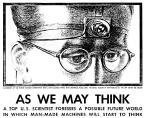
Vannevar Bush : as soon as 1945, a vision of the hyper-communicating world of XXIth century.
Several thinkers write about the formalisms in art, like Max Bense (poetry and aesthetic theory) of Vannevar Bush and his famous "As we may think". On the opposition side, we can quote Hans Haacke, a conceptual writer and anti-fascism activist.
But fears about new technologies are strongly expressed by George Orwell in Nineteen eighty-four (1949).
Christopher Strachey, Permutational use of text.
Music
Music, downstream to Wagnerian peak, splits itself progressively into popular and savant music. This last one has been radically digital since Schönberg.
In 1951, is founded in Cologne (Germany) the Studio fûr Elektronische Musik. See [Leloup, 2013] p. 50
A new music develops along two complementary axes: formal concepts and new sounds. These are
- got from the recording of elementary and natural sounds, used as materials by the composers (concrete music), and electronically transformed,
- created ex nihilo using synthesizers.
Most of the artists work on the both sides. Technology demands new musical theory, and more complex composition formulas are happy to be freed from the structural limits of the traditional acoustic instruments.
We can distinguish two orientations:
- a formal/abstract one with the serialism,
- a material/technological one with the electronic instruments. But several
artists work on the two sides.
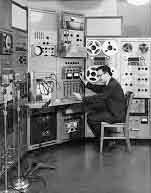
Lejaren Hiller, working at University of Illinois in 1963, from Computer History website.
Computer Cantata
Lejaren Hiller, 1963 (Youtube)
Les créatures
Pierre Barbaud 1966 (Youtube)
Serialism and algorithms
Milton Babbitt.
Léonard Isaacson Works with Hiller.
Gottfried-Michalel Koenig Algorithmic.
Luigi Nono Serialist.
Arvo Pärt. .
Henri Pousseur . Dodecaphonist.
Karl-Heinz Stockhausen Sounds and composition.
Electronics
Louis and Bebe Barron develop the first entirely electronic score for Forbidden Planet (1956) , a science fiction film loosely based on William Shakespeare's The Tempest.
Luciano Berio. Electronic instruments and nearly serialist structure.
John Cage. William Mix, his first magnetic tape work in 1952. (Indicated by [Debatty]).
Fritz Enkel The beginning of "electronic music".
Grace Hertlein Painting, then music.
Lejaren Hiller Computer generated sound, works with Cage. He composes The Illiac suite for string quartet in 1956,
Olivier Messiaen Composer.
Thelonius Monk Electronic, jazz.
Les Paul Lover (When You're Near Me) (1948) , his first multitrack recording, released by Capital Records (Indicated by [Debatty]) and first solid-body electric guitar. (1940)
Pierre Schaeffer, Journal
de la musique concrète (1949): fragments of natural sounds (1949),
then combination. He will relate his experiences in Traité des
objets musicaux (Seuil 1966)
Edgar Varese Composer. Electronic poem on electronic tape (1958)
Other artists:
Kokyokyoku Nehan Japan A
Guttman Newman USA
Mathews Max USA
Tenney James USA
Ussachevsky Vladimir USA
Painting, photography
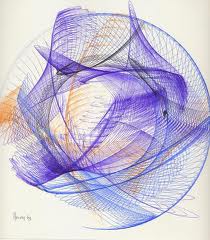
Henry Desmond Paul. This work, mechanically done, foresees some programmed works by Jean-Pierre Hébert, for instance.
After the war, the painting lead is taken from Paris by New York. Here also, it is more in the extension of former ideas that the concepts evolve. But the war horrors take to more contestation and to the post-modernism.
After some pre-digital advances, we find in this period the roots of truly digital graphics. [Masson] writes: "A very blurred line is crossed somewhere between mechanical and analog computer assisted grahics and the first directly digital computer generated graphics".
At MIT in 1948, the first radiosity image, by Moon and Spencer. [Masson]
Predigital.
Henry Desmond-Paul uses bomber analog machine, bought on a flee-marked, to generate images, rather similar (but more complex) that those of the Harmonograph (1840, see this period).
Yves Klein assigns a number to his blue,
used for monochromatic works (IKB 191).
The Oupeinpo group applies to painting the combinatorial/random principles of Oulipo.
In 1952, Turing writes The Chemical Basis of Morphogenesis (see Wikipedia.) which foretell generative and bio-art.
Digital.
On this period, the computer has no artistically interesting printing device. Neither the tabulators used as printers nor the teletypes lend themselves to artistic composition. Some possibilities are offered by the typewriter, on which the artist can play on hand displacements of the paper and multiple hits on a same place to get more dense parts.
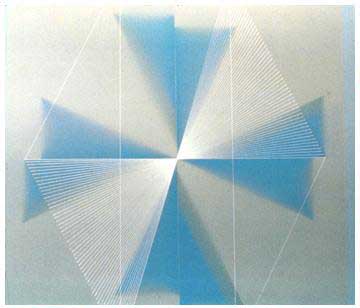
Eduardo Macentyre
Then the hand of the artist remains necessary, even whey they use computer computations. Albert Ducrocq presents what we think is the first pixelized image. He paints it by hand, following the commands given by his digital/random machine Calliope. Sophisticated curves are used by Victor Vasarely . Intellectually daring, Eduardo Macentyre and Miguel-Angel Vidal
founds th Generativo Art movement.
Social aspects are dealt with by Gustav Metzger
using different media for his environmental engagement. André
Malraux publishes The voices of silence, stressing the importance of photograhy
and mass reproduction of photographies for art distribution, critic and creation.
It is also during this period that photography and cinema extend beyond the space of some laboratories or specialized studios and spread among a large public. Chemical photography, of course, is probably the most analog, and not digital, among all the arts other than performance. Cinema, on the other hand, is basically built on fragmentation of movement into successive still images (which is probably the first large scale use of signal sampling).
Cinema
Ben Laposky uses osciloographs type devices to create animated images. John Whitney. Customized analog computers for visual art (1958)
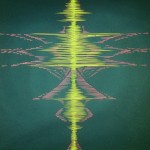
Disey's Fantasia (1940): animation image with sound waves visualization.
Sound science and electronics highlight the Fantasia (1940) film of Walt Disney, inspired by Norman McLaren and the algorithms of Fishinger.
Sculpture, design, architecture
Nicolas Schoeffer and his Cybernetic
tower (1956) dominate this period, where digital begins to take place.
But, in general, he uses analog programming devices (camshafts).
It has been rebuilt, with more modern technology, in 2016. See Dada
Compart
Sculpture
Judd Donald Simple plastic objects. How far digital ??
Soto Jesus-Rafael
Kinetic art
In 1955, Galerie Denise René in Paris organizes Le Mouvement show. We are in the pre-digital, of course.
Paul Bury Similar to Tinguely
Gruppo N. Alberto Biasi,
Ennio Chiggio, Toni Costa, Eduardo Landi, Manfredo Massironi.
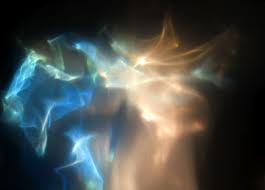
Frank Malina. FLowers (1964).
Julio Le-Parc A member of Grav (see the 1960's)
Heins Mack Mirrors.
Nam-Jun Paik
Nikki de Saint-Phalle Works with Tinguely.
Happy colors but not digital.
Tinguely Jean
Frank Malina opens the link between kinetic art and computing.
Light
Nino Calos. Rather complex. See a work on Ensad site.
Dan Flavin Minimal art
Gyula Kosice Neon tubes.
Gregorio Vardanega. Small lights (not LED) on sculpture.
Sculpture opens itself to new technologies. Here, digital art is preceded by kinetic art (Tinguely for instance), light art (Morellet in the next decade) and cybernetic art (Schoeffer).
Performance.
Kaprow Allan USA Y Interaction, action painting... mainly known for his creation of the happening as art concept.
Games
First videogame, Tennis for Two, in 1958, by William Alfred Higinbothem.
(not artistic)
DICCAN'S PARTNERS:
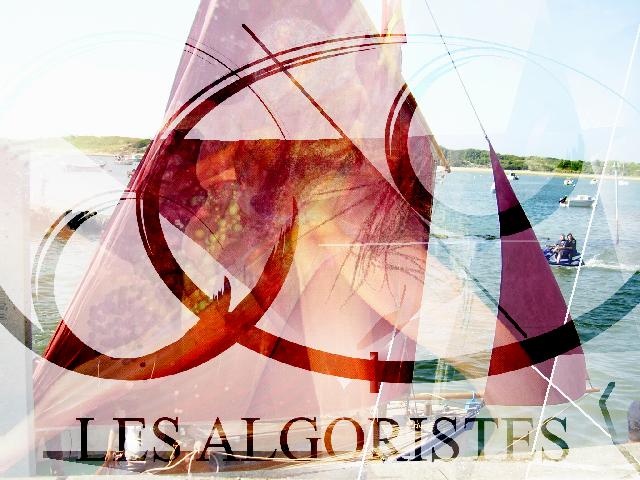
Les Algoristes, an association of artists using their own algorithms in their work.
